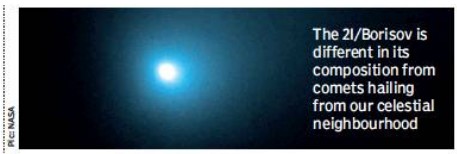Why in news?
Deep-space ice formed in one of the coldest parts of the cosmos has been found in our solar system.
21-Borisov was in the news in the past: It was the first such identified interstellar comet to have come close to the Sun from another stellar system.
Details

- Deep-space ice was carried on a comet that formed far from its host star, where temperatures could reach minus 250 degree Celsius.
- Named 21/Borisov, the comet 800 metres wide with a tail almost 1,60,934-km long, was spotted just outside the orbit of Mars.
- Scientists have found the coma- a fuzzy outer layer of light- contains water and a lot of carbon monoxide.
- Carbon monoxide, poisonous to humans, is a common gas in space and forms as ice only in the most frigid locations.
- The presence of so much carbon monoxide suggests 2I/ Borisov was formed — in a very cold outer region of its home star system or around a star cooler than the Sun.
What are Comets?
- A comet is an icy, small Solar System body that, when passing close to the Sun, warms and begins to release gases, a process called outgassing.
- This produces a visible atmosphere or coma, and sometimes also a tail.
- These phenomena are due to the effects of solar radiation and the solar wind acting upon the nucleus of the comet.
- Comet nuclei range from a few hundred meters to tens of kilometers across and are composed of loose collections of ice, dust, and small rocky particles.
- The coma may be up to 15 times Earth’s diameter, while the tail may stretch one astronomical unit.
- Comets have been observed and recorded since ancient times by many cultures.
-Source: The Hindu




